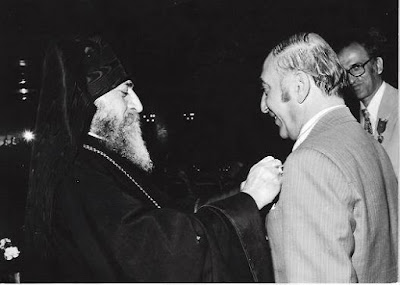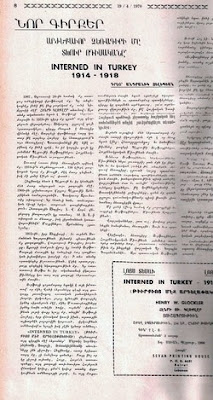The attached is reproduced from a booklet, presumably published in the early 1950s, by the Catholicosate of Cilicia for fundraising purposes. It presents a brief history of the re-establishing of the Catholicosate of Sis in Antelias, Lebanon and conveys its needs during its early years.
HISTORICAL STATEMENT
In 1921, after the massacres and the deportation of the Armenians from their fatherland, Sahag II, Catholicos of Cilicia, took refuge in Syria with the remnants of his flock, numbering about 200,000. Until 1930, His Holiness, himself a refugee, did not have religious quarters in which to reside, nor facilities to organize the spiritual and educational affairs of its people. Prior to 1921, for several centuries, the Seat of the Cilician Armenian Catholicosate has been Sis in Cilicia. At the present time, although the seat is established in Antelias, Lebanon, nevertheless the Holy See reserves its original historical name, viz., THE ARMENIAN CATHOLICOSATE OF CILICIA.
The American Near East Foundation had been helping the Armenian refugees to settle in Syria and Lebanon, had an orphanage for Armenians since 1922 in Antelias, a village about six miles from the city of Beirut, Lebanon This orphanage with its buildings and premises, had been vacant since 1928. Upon the petition in 1929, of the Catholicos to the Executive Committee of the Near East Foundation, they were put under his disposition for a period of five years to be used as the Seat of the Catholicosate and as a Seminary for training priests and teachers, to meet the religious and educational needs of the Armenians in the Near East. The Executive Committee also determined to contribute $6000 to $7000 yearly, and some Armenian benefactors an additional $5000 for the maintenance of the Seminary.
Catholicos Sahag invited Bishop Papken Gulesserian as Catholicos Co-adjuctor, and Shahe Vartabed Kasparian of Boston, Mass. as Dean of the Seminary, in order to organize the Dioceses of the Holy See and lay the foundation for the Seminary. In the years to follow, these two noble clergymen became the soul and the pillars of the Catholicosate and the Seminary.
After the celebration of the Divine Liturgy on Sunday, October 12, 1930, the Seminary was officially opened: classes were started the following day with an enrollment of 38 students.
Upon the completion of this period of five years, the Near East Foundation discontinued its annual appropriation and the Seminary was left to the meager resources of the Holy See. As a consequence, the number of students, previously 43 to 45, was lowered to about 20.
Unfortunately, in November 1935, the Dean of the Seminary died. A few months later, the Holy See lost Catholicos –Coadjutor Papken Gulesserian. Their death was a severe blow to the ‘newly flowering'" Seminary and the Catholicosate. But the venerable 88-year old clergyman, Sahag II, was never despondent, he appointed Archbishop Bedros Sarajian as his Locum Tenens. The latter opened a campaign to secure financial means for the purchase of the Antelias property and for the sustenance of the Seminary and the Catholicosate. Many Armenians responded to the call. Mr. and Mrs. Simon and Mathilda Kayekian of Cairo, Egypt, made possible the purchase of the property from the Near East Foundation by a generous donation of $19,000. From the contributions of the people, a sum of $30,000 was raised, with which a new Seminary building and a residence for the Catholicos were erected.
On May 10, 1943, Archbishop Karekin Hovsepian, the Prelate of the Armenian Church in North America was elected Catholicos of Cilicia. Before his coming to Anetlias, his Golden Jubilee had been celebrated in the United States and in Egypt, and all the proceeds, amounting to $100,000, were allotted to the Holy See. The faculty of the Seminary was increased by new competent professors. The number of students was raised from 22 to 43. Terenig Vartabed Poladian of New York was appointed Dean of the Seminary.
Antelias, once an orphanage, is now a center of learning and knowledge giving forth its good fruit in due season. This Seminary is truly called "The noblest Armenian educational enterprise in the Near East".
THE SEMINARY
The Seminary is the center of religious education of the Catholicosate. Its aim is to prepare young men enriched in faith, knowledge, and vision as qualified clergy or teachers thoroughly devoted to the ministry of the Holy Armenian Church and the Armenian people.
At present, the Seminary has 38 students. In October 1948, the number will be raised to 53. The faculty is composed of eleven professors. It is the only institution in Diaspora, which possesses a faculty of such high reputation. The Dean is Bishop Terenig Poladian.
The Seminary has two divisions:
The Preparatory Institute (Jarankavorats - Ժառանգաւորած): This is composed of our years' course for advanced education, dealing mainly with languages, sciences, mathematics, and history.
The School of Theology (Entsayaran - Ընծայարան): This is composed of three years' course in theological and philosophical studies.
The Seminary provides facilities for recreation in sports and games, such as tennis, volleyball, basketball, and swimming.
Students participate also in extra-curricular activities, such as religious and social work.
Graduates: So far the Seminary has produced 20 clergyman and 42 teachers. These graduates are serving in various Armenian dioceses, institutions, and schools in Syria, Lebanon, Palestine, Cyprus, the United States, and Armenia, in the capacity of prelates, principals, and teachers.
The Seminary sends some of its graduates to American and European Universities to acquire them with Western thought. These graduates, upon their return, devote themselves to teaching.
CATHEDRAL OF ST. GREGORY THE ILLUMINATOR
The Cathedral was constructed in 1938-40 through the generous donation of an Armenian who remained anonymous until after his death when his son disclosed him to be Mr. Sarkis Kenadjian, from Constantinople. The Cathedral is one of the largest and most beautiful buildings in Lebanon.
MARTYRS MEMORIAL CHAPEL
The Chapel is dedicated to the memory of millions of Armenians who were massacred with ineffable brutality by the Turks during the First World War. Every year on April 24th, a commemorative Holy Mass is celebrated. From the dome hangs an unquenchable lamp symbolizing Eternal Light shining over the Souls of the Martyrs.
THE LIBRARY
The Library contains catalaqued about 8000 bound volumes and 3000 pamphlets. There is also a collection of manuscript material. The volumes are crowded in wooden shelves; steel stacks are urgently needed. There is a great want for encyclopedias, dictionaries, and books in English, French, and Armenian on theology, literary and educational subjects.
OTHER FACTS
The Armenian Catholicosate of Cilicia comprised of 160,000 people has four dioceses, Aleppo, Lebanon, Damascus, and Cyprus. The people are economically poor, especially since the outbreak of the hostilities in Palestine. The annual expenditures of the Holy See amount to about $48,000. The normal income is only about one-third of this sum. The greater part must be provided by the generous contributions of the benefactors and pious people. The Seminary has a few benefactors in the United States, Egypt, Cyprus, France, and England, each of whom pays the annual expenses of a student, who has been adopted in his name. It should be noted that the tuition, room, board, clothing, physical care, etc. of the students are provided by the Seminary, free of charge. the yearly cost for each Seminarian is $750.
THE NEEDS OF THE HOLY SEE
Library building
Seminary Annex building
Linotype
Rooms for Vartabeds and Deacons.
Benefactors for adopting students in their names.
Memorials may be established for donations made towards filling these needs. in part or in whole. In whatever form given, the memorial lives on in the Church and through the students who receive its benefit. The memorials are commemorated annually on a special day, during the celebration of the Divine Liturgy.
Such donations, or will be made through the Association to Aid Catholicosate of Cilicia which was established in 1944 by His Holiness Karekin Hovsepian. The association maintains branches in many cities. The address of the Executive Committee is Mr. Mihran Karagheusian, 295 Fifth Avenue, New York, NY, or through
THE ARMENIAN CATHOLICOSATE OF CILICIA
ANTELIAS, LEBANON.
Note: The date of the publication is not noted. It presumably is in the early 1950s.















